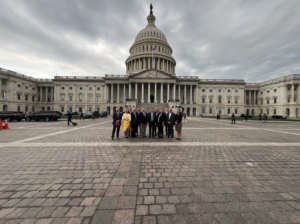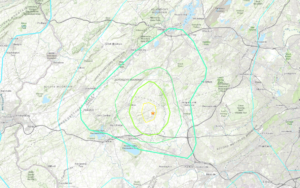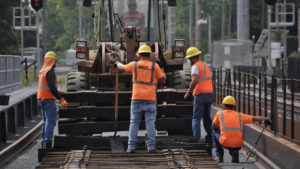New half-mile railroad bridge replaces historic Boone trestle
Written by jroodFreight trains have begun moving across a new $43-million bridge over Iowa's Des Moines River that reportedly is the tallest double-track railroad structure in North America, the Des Moines Register reports. The Boone High Bridge, which is 2,550 feet long and 190 feet high, will improve operational efficiency and customer service on Iowa's busiest railroad corridor, said Mark Davis, a spokesman for the Union Pacific Railroad, which commissioned the bridge project.
About 60 freight trains
are running daily across the new bridge, which went into service Aug. 20 about
three miles west of Boone, Davis said. The structure’s opening has also marked
the end of service for the nearby historic Kate Shelley Bridge.
The Kate
Shelley Bridge, more than a century old, dates to the era of steam engines
puffing smoke as they chugged through Iowa. The aging bridge, which is just
south of the new bridge, is about 185 feet tall. The old structure will remain because
it is a historic landmark, although it won’t handle train service, Davis said.
The Kate Shelley Bridge
has been a tourist attraction for decades, and the new bridge will be, too,
said Fenner Stevenson, general manager of the Boone & Scenic Valley
Railway, a tourist railroad. His trains operate on their own tracks and do not
use the Kate Shelley Bridge.
"People who love
railroad bridges can see two of the tallest bridges in the world right
here," Stevenson said. "Countless numbers of people come to Boone to
ride our train and then they say, ‘How do we get to the Kate Shelley High
Bridge?’ "
The Kate Shelley Bridge
has long been a marvel for railroad historians because of its impressive height
and design and also because of the story surrounding the bridge’s namesake.
In
1881, Kate Shelley, 15, made her way by lantern through a ferocious storm to
warn a railroad agent that the storm had washed out a railroad trestle south of
Boone, wrecking a train. Because of her effort, the agent was able to halt an
oncoming passenger train.
The Union Pacific’s new concrete
and steel structure can accommodate two freight trains operating at speeds up
to 70 mph. The old bridge could only serve one train at a time, with a speed of
about 25 mph.
The new structure will eliminate a bottleneck for trains
traveling a major corridor between the West Coast and Chicago, said Craig
O’Riley, a planner for the Iowa Department of Transportation.
The Union Pacific’s main
line across Iowa carries coal from Wyoming’s Powder River Basin, as well as
freight containers from the West Coast that began their journeys on ships at
Asian ports. The trains also haul grain and mixed freight.
"The new bridge
makes a lot of sense," O’Riley said. "Think of driving across the Des
Moines River in your car and saying, ‘I can’t be on the bridge with any other
cars.’ It’s a big issue."
The contractor for the
new bridge’s construction was OCCI Inc. of Fulton, Mo. The engineering was
handled by HDR Engineering Inc. of Omaha. Work on the bridge began in late 2006
with the goal of finishing in November 2008. But construction ran late.
"The project was a
challenge with its height and design," Davis said.
A formal ribbon-cutting
for the new bridge is planned Oct. 1.
The bridge construction has been closely
watched in Boone, which has a long history of involvement with the railroad
industry. Many of Boone’s 12,803 residents have worked for the Union Pacific or
the former Chicago & North Western Railway, or are involved with the Boone
& Scenic Valley Railroad.
Former Boone mayor George Maybee, a former
railroad division manager, said he’s impressed with the towering new railroad
structure. He toured the bridge while it was being built, and he’s watched
freight trains on it.
"It’s beautiful, and
when you see the two of the bridges together, it’s really something," he
said.





